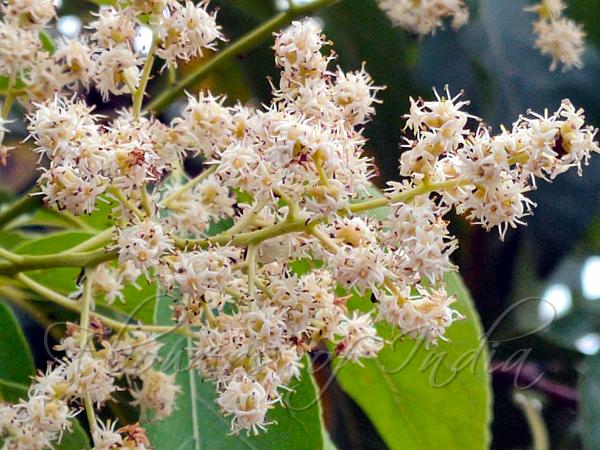|
| Chinese Sumac |
|

|

|
|
|
|
Photo: |
Botanical name: Rhus chinensis Family: Anacardiaceae (Cashew family)
Synonyms: Rhus semialata, Rhus javanica var. chinensis, Rhus amela
Synonyms: Rhus semialata, Rhus javanica var. chinensis, Rhus amela
Chinese Sumac is a shrubs to small tree, 2-10 m tall,
with branchlets rusty velvet-hairy, warty. Leaves are stalkless,
imparipinnately compound; axis broadly winged to wingless, rusty
velvet-hairy; leaflets 7-13; leaflet blade ovate to oblong, increasing
in size toward tip, 6-12 × 3-7 cm, above dark green, sparsely
velvet-hairy, below lighter green, glaucous, and rusty velvet-hairy,
margin toothed, often rounded toothed, tip pointed. Flowers are borne
in many branched clusters, densely rusty velvet-hairy, male ones 30-40
cm, female ones shorter. Flower-stalks are about 1 mm, minutely
velvet-hairy; flowers white or pale yellowish-green. Male flowers:
calyx minutely velvet-hairy, sepals long ovate, about 1 mm, with
fringed with hairs margins; petals obovate-oblong, about 2 mm; stamen
filaments about 2 mm, anthers ovoid, about 0.7 mm; disk annular; ovary
reduced to absent. Female flowers: sepals about 0.6 mm; petals
elliptic-ovate, about 1.6 mm; staminodes much reduced; disk annular;
ovary ovoid, about 1 mm, densely white velvet-hairy, styles 3, stigma
capitate. Fruit is spherical, slightly compressed, 4-5 mm in diameter,
mixed hairy and glandular-velvet-hairy, red at maturity. The milky
juice of this and other species causes irritation of the skin. Chinese
Sumac is found in the Himalayas, from Kashmir to Bhutan, NE India,
Ceylon, Burma, east to China, Korea, Japan, at altitudes of 1300-2400
m. Flowering: August-October.
Medicinal uses: In Manipur, fruits and leaves
are used in colic and bark in dysentery.
Chinese galls are used in
Chinese medicine to treat coughs, diarrhea, night sweats, dysentery and
to stop intestinal and uterine bleeding.
In Manipur, fruits and leaves
are used in colic and bark in dysentery.
Chinese galls are used in
Chinese medicine to treat coughs, diarrhea, night sweats, dysentery and
to stop intestinal and uterine bleeding.
Medicinal uses:
 In Manipur, fruits and leaves
are used in colic and bark in dysentery.
Chinese galls are used in
Chinese medicine to treat coughs, diarrhea, night sweats, dysentery and
to stop intestinal and uterine bleeding.
In Manipur, fruits and leaves
are used in colic and bark in dysentery.
Chinese galls are used in
Chinese medicine to treat coughs, diarrhea, night sweats, dysentery and
to stop intestinal and uterine bleeding. | Identification credit: Thingnam Sophia | Photographed in Imphal, Manipur. |
• Is this flower misidentified? If yes,